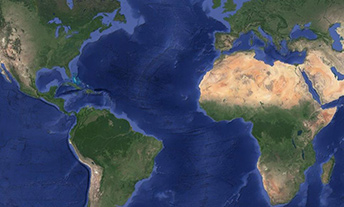
Arttu Sainio
NASA Citizen Scientist
Contents
- What motivated you to volunteer as a NASA citizen scientist? How did you learn about NASA citizen science?
- What do you do when you’re not doing science with NASA? Tell us about your job and your hobbies.
- Which peer-reviewed research publications have you contributed to through your citizen science work? What was your role in the research and writing process?
- What are your favorite NASA citizen science projects to work on, and why?
- What have you discovered or learned as a NASA citizen scientist?
- What advice would you give to others who might want to volunteer with NASA citizen science?
- Where are they from?
What motivated you to volunteer as a NASA citizen scientist? How did you learn about NASA citizen science?
I’ve always been fascinated by the cosmos. When I was a kid, I remember staring up at the stars while other kids were playing with their toys. My mother had a hard time answering all my questions about the universe. My life took different turns, but about five years ago I found citizen science projects, and since then I have been studying science and doing independent research. I feel the circle has closed and I am finally at home.
What do you do when you’re not doing science with NASA? Tell us about your job and your hobbies.
I had a career in the restaurant business and food industry, but at some point, I lost my passion. Later I became a job coach. I enjoy hiking and jogging in nature. A few times a year I do some longer hikes. Those can vary from a one-day, 40-kilometer (25-mile) hike to a 160-kilometer (99-mile), four-day march. I relax by doing crafting projects in the summer. For example, I made a desk for my computer setup, and I like repairing old storm lanterns.
Which peer-reviewed research publications have you contributed to through your citizen science work? What was your role in the research and writing process?
I have contributed to multiple peer-reviewed publications with the Backyard Worlds: Planet 9 team, each of which is listed on the Citizen Science Publications page. Some have yet to be published. The first paper I contributed to was “WISEA J041451.67–585456.7 and WISEA J181006.18–101000.5: The First Extreme T-type Subdwarfs?” I discovered WISEA J181006.18−101000.5 (J1810 for short) by chance when I was sipping my morning coffee and going randomly through WISE (Wide-field Infrared Survey Explorer) satellite images from a random part of the sky. This object ended up being rather interesting because models suggested it might be located under 10 parsecs (pc) from our Sun (a parsec is approximately 3.26 light-years). All new objects within 10 pc would be major discoveries. Most new brown dwarfs that we have found are 30 pc or more from our Sun. However, we had to scrap these estimates because in our follow-up observations, we discovered that J1810 has extremely low metallicity, which made the photometric estimations challenging. But that also made the object very interesting. Recently, a follow-up study of object J1810 by N. Lodieu et al. placed it again under 10 pc distance from the Sun. So that is very cool!
After we published on these first low-metallicity T-type dwarfs, I adjusted my search methods so I would be more likely to catch objects like this in my searches. And we have now found a few other similar candidates, which we described in our later paper. We have a few more to publish in the future.

Usually, I do massive catalog searches where I combine large amounts of data from different infrared and optical surveys to find the faintest brown dwarfs near our solar system. I combine Python and SQL (Structured Query Language) in my queries. This method has become quite effective at finding extreme T-dwarfs and very cold brown dwarfs. My method has found hundreds of brown dwarf candidates. Some of them have been confirmed and included in papers such as “Spitzer Follow-up of Extremely Cold Brown Dwarfs Discovered by the Backyard Worlds: Planet 9 Citizen Science Project” and “The Field Substellar Mass Function Based on the Full-sky 20-pc Census of 525 L, T, and Y Dwarfs.” The Spitzer Follow-up program was very exciting for me because that was the first time some of my objects were observed by a space telescope. Later, my efforts were further rewarded when my objects were followed not just by Spitzer but also by Hubble and soon by the James Webb Space telescope.
My work continues. I adjust my methods when I discover new data sources and get new ideas. Currently, I am interested in mining new data sources that I don’t believe have been used before to find brown dwarfs. I hope this might reveal some unknown brown dwarfs near our galactic plane. In my pocket, I have a good idea for finding variable brown dwarf candidates. Brown dwarf variability is something scientists are currently very interested in, so I hope I can contribute to that.
I want to thank everyone in Backyard Worlds: Planet 9 for their phenomenal support. It is a pleasure to work with this group.
What are your favorite NASA citizen science projects to work on, and why?
I tend to join projects that help me learn the next science topic I’m interested in, but Backyard Worlds: Planet 9 is definitely my home. That is where my story started and where I will always return. I still do some projects for Backyard Worlds: Planet 9 and I have awesome ideas for the future. Generally, I prefer projects that have an open data policy so participants can have access to raw data. That gives me the opportunity to dig deeper and learn more and also to start independent research. I have learned a lot about light curves in projects like Planet Hunters TESS and Planet Hunters NGTS (Next-Generation Transit Survey). I have learned a lot about solar system dynamics in projects like Catalina Outer Solar System Survey, Hubble Asteroid Hunter (concluded), and Active Asteroids. Each of these projects has served as a step in my learning journey.
What have you discovered or learned as a NASA citizen scientist?
We live in a world with a lot of misinformation and false beliefs. Open data and citizen science are important tools for people who are interested in developing critical thinking skills to better assess their environment. Not everyone will make a huge discovery through citizen science, but we can each learn some scientific thinking that will help us weed out false and harmful beliefs.
What advice would you give to others who might want to volunteer with NASA citizen science?
The universe belongs to all of us and everyone can do science. Anyone interested should go to sites like Zooniverse and scroll through different projects and just try them. It does not matter if you have just 15 minutes a month or two hours every day. Each effort helps and that is the power of citizen science. Once you’ve found a project you like, I encourage you to take your time, be patient. It is not a sprint. Read the talk pages and ask questions. Try to learn something new every time you participate. The more you learn, the better able you will be to recognize something interesting in the data.
I have received a lot of help from the community. Helping others is the way that I show my respect and appreciation for the help I have received. I think many of us feel the same way.
Visit the complete collection of NASA citizen science projects and start contributing today!
Where are they from?
Planetary science is a global profession.




























